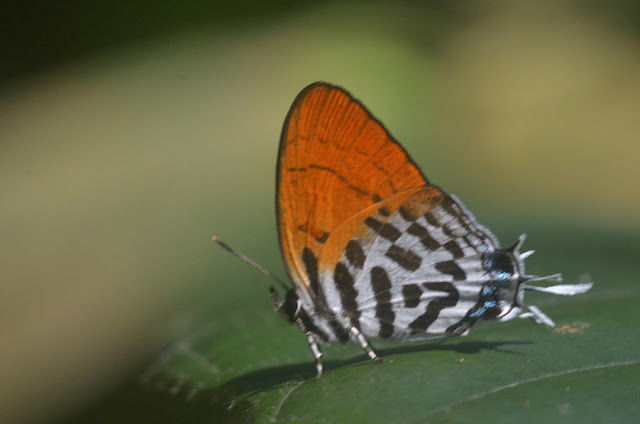We lost some greenery and cemetery ground at Bukit Brown due to the construction of the Lornie Highway but we gained a very serene and beautiful Lornie Nature Corridor. Since its official opening in Nov 2020, this 1.7 km nature corridor has become one of my favourite hiking cum butterfly-photography trails.
The nature corridor runs parallelly to the old Lornie Road. Flowering shrubs such as Leea rubra and different kind of tropical trees with name and descriptions are planted along the road.There are two entrance points to the MacRitchie Reservoir Nature Reserve. Usually I went into the nature reserve and came out from the other entrance point near the golf course.
A long-tailed and elegant lycaenid, the Branded Imperial (Eooxylides tharis distanti) is a common denizen in the forest. Very often, this species loves to perch on its larval host plant, a forest climber the Bearded Smilax (Smilex bracteata).
A rare occasion like this is what we hope for - two in one frame is nice (yes, forget about the restrictions of "social distancing"!)
Another orange lycaenid, the Yamfly (Loxura atymnus fuconius) was spotted hopping at the same Smilax vine. This was not a surprise as its larval host plant is the same vine.
Another common beauty that can be found along the stretch of forest trail that is parallel to the nature corridor is the Common Posy (Drupadia ravindra moorei).
The male Cruiser (Vindula dejone erotella) is a conspicuous forest species with an orange "outfit". The females look very different from the males which like to puddle on leaf litter or on the ground.
This is another specimen when he was licking liquid on a cement seat.I recalled that I was having a hard time shooting this Malayan Lascar (Lasippa tiga siaka). It was sensitive to the camera flash light and never stayed still on the ground for me to take a closer shot.
A Large Fourline Blue (Nacaduba pactolus odon) was found fluttering at the ground level and occasionally, it stopped for a short while.
In recent years, the Grey Pansy (Junonia atlites atlites) has become common in many locations. This shot was taken near the golf course area.





































